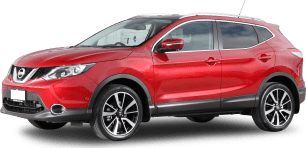The MY18's launch will see four Nissan Qashqai models on the price list: the ST, ST-L, N-TEC and Ti. The N-TEC will be with us throughout early 2018 when the advanced safety technology of the Ti becomes available. The current plan is that the N-TEC will disappear when that happens.
The 2018 Qashqai introduces a number of new features as standard across the range. All of them now have forward collision warning, auto emergency braking and lane departure warning. These are in addition to front and rear parking sensors and the reversing camera carried over from the 2017 models.
Pricing hasn't moved very much, meaning how much you pay for a Qashqai has only changed due to the new spec level and the end of the diesel models. The ST is up by $500, the ST-L and N-TEC don't really have obvious counterparts given the demise of the diesel and the petrol Ti is $1000 more. Having said that, the ST-L is $1000 cheaper than the old TS.
Pricing for the ST range opener kicks off at $26,490 for the manual and $28,990 for the CVT auto. Rolling on 17-inch alloys, the ST has a six-speaker stereo, cruise control, cloth trim, keyless entry and start, air-conditioning and a space saver spare tyre.
The ST's sound system is powered by a 5.0-inch touchscreen and features an AM/FM radio, CD player, MP3 player and you can connect your iPhone or Android device via USB or Bluetooth. Sadly - and this goes for the whole range - there is not yet Apple CarPlay or Android Auto support.
Next up is the ST-L, starting at $32,990. On top of the ST spec you'll get 18-inch alloys, roof rails, fog lights, electric and heated folding mirrors, GPS sat nav, partial leather seats, heated seats, electric drivers seat and around-view cameras (as well as the normal reversing camera).
The infotainment screen is pumped up to 7.0-inches and DAB+ digital radio joins the list.
The gadgets list expands with the N-TEC, which will stick around until the Ti's arrival. Priced from $36,490, this one includes 19-inch alloys with fatter tyres, LED headlights (in addition to the LED daytime running lights), dual-zone climate control to replace the standard AC, auto headlights and wipers, panoramic sunroof, rear centre armrest, auto parking and mood lighting. The safety list expands with blind spot monitoring, high beam assist and reverse cross traffic alert.
The $37,990 top of the range Ti will land sometime before the middle of 2018. Compared with the N-TEC, the Ti is basically the same but adds nappa leather interior, lane keep assist and active cruise control.
Should the N-TEC be wildly successful, would it stick around? We asked, but Nissan wouldn't speculate. The reason for the Ti's late arrival is related to production availabilty of the lane keep assist and active cruise combination.
Those looking for more exotic colours like orange or gold will sadly miss out.
As for the colour choices, there are now eight colours for the Qashqai. As before, 'Ivory Pearl' (white) and 'Pearl Black' are no extra cost. The remaining colours - 'Platinum' (a light grey silver), 'Gun Metallic' (dark grey), 'Night Shade' (a sort of purple blue) and 'Magnetic Red' all cost $495. The new 'Vivid Blue', which is exactly what it sounds like, is new to the range and is also $495.
Those looking for more exotic colours like orange or gold will sadly miss out and the earthy tones of brown are also unavailable.
For a more detailed comparison, see our model snapshots.





